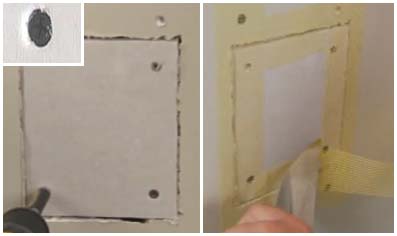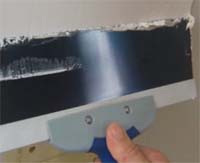|
We find holes in drywall everyday, and to call a
professional to repair them can be expensive. So I thought I
would share some tips for those that are inclined to do it
yourself To fix holes in drywall like those caused
by a doorknob, you will need these materials:
a piece of drywall, backer boards (1x2 or plywood strips),
drywall mud (called mud for this article) tape, screws, primer and paint to finish the job. Tools
include, dust mask, pencil, flashlight, measuring tape, utility knife,
drywall saw, screw gun, putty knife, painting tools and a drop
cloth.  Always
wear a mask when working with drywall. Always
wear a mask when working with drywall.
Start
with a flashlight and carefully look inside the hole for any wires
or plumbing in the way. If you see any, note its location
so you can avoid damaging them when you cut out the damaged area.
Measure
the hole and cut a piece of drywall a little larger
than the damaged area to be patched. Hold
the patch over the hole and trace around it with a pencil.  Cut
along the lines you traced with a drywall saw, be careful to avoid
any wires or plumbing! Cut
along the lines you traced with a drywall saw, be careful to avoid
any wires or plumbing!
Cut some backer
boards, (1x2 or plywood strips should work fine) that are 4 inches
longer then the hole. This will allow you to put screws into
the ends to secure
them. Be sure to 'dimple' all screws below the face of the
sheetrock otherwise they will be in the way when you finish the
drywall with mud.  Place
the patch you traced in the hole and secure it with drywall
screws. Place
the patch you traced in the hole and secure it with drywall
screws.
Cover all the seams with drywall
tape, in this example we are using a fiberglass mesh. Alternately
you can use paper fire tape that you embed with drywall
mud.  Coat
the nails and tape with mud, smooth it out and let it thoroughly
dry (usually a day). Using a clean putty knife, scrape off
all the high spots, and very gently sand the surface. Use
care do not to ever rough up the paper facing on the drywall. Coat
the nails and tape with mud, smooth it out and let it thoroughly
dry (usually a day). Using a clean putty knife, scrape off
all the high spots, and very gently sand the surface. Use
care do not to ever rough up the paper facing on the drywall.
Put
on a 2nd coat of mud, and feather the edges out a few inches
wider than the first coat. Allow to dry and again scrape and sand
as needed. A third coat may be used if the surface is not
smooth enough. Add
texture if needed (there is a aerosol texture you use) prime
and paint. Some tips to help you with drywall mud:
1) Mud will spread much easier
if you mix it first. Put a small amount in a mud pan, and mix it
well with a putty knife. You can add a very small amount of water
when mixing, and it will help too.
2) It is easier to use 'lightweight mud", it spreads easier then regular mud.
3) Always work from a mud pan in small batches, never from your
bucket of mud. If you do, you will almost always contaminate
the mud in the bucket and get chunks of debris make finishing
smoothly nearly impossible.
4) Using a spray bottle of water, you can very lightly mist the patch and this
will give you more time to work the surface smooth
5) If you use a wide knife instead of a narrow one, you will have
fewer passes to cover the patch, making it easier to finish.
If you want professional help with your home repair
projects give us a call, we are happy to make referrals to some
great contractors.
| ![]()
